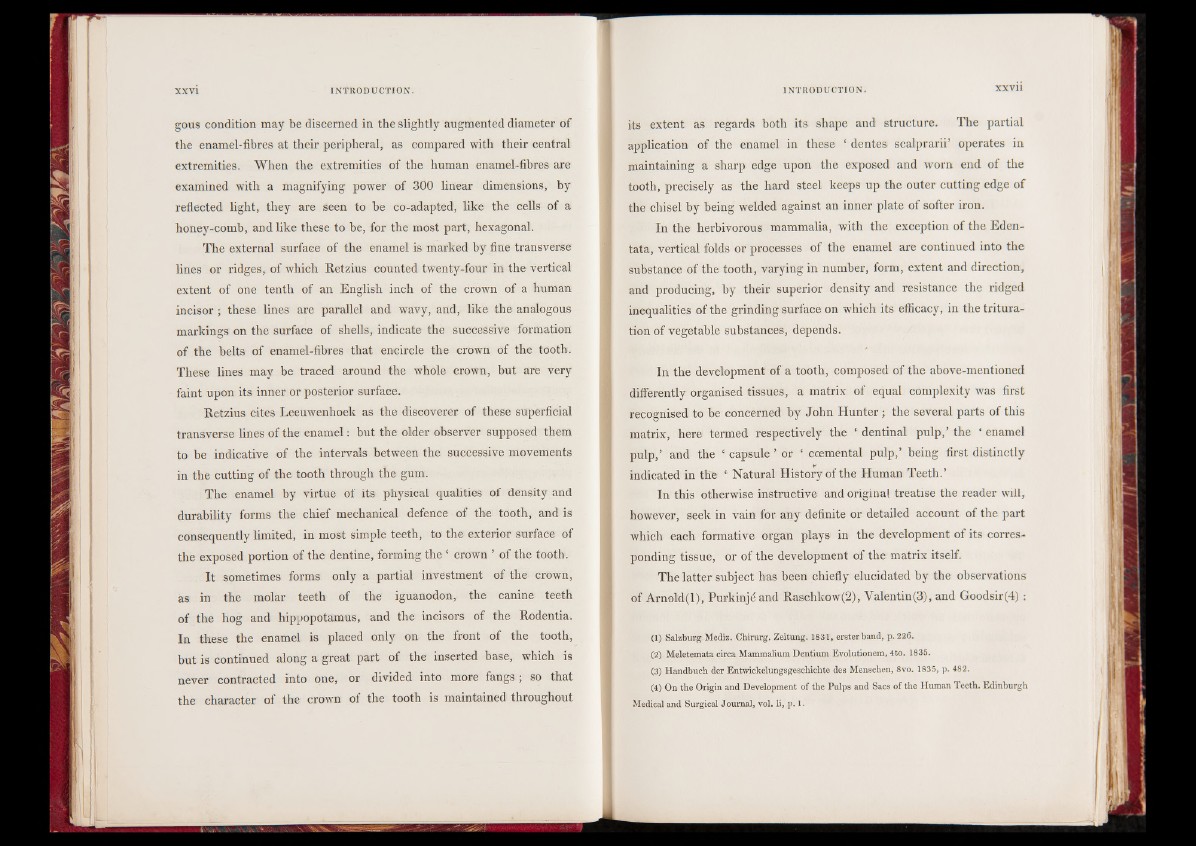
gous condition may be discerned in the slightly augmented diameter of
the enamel-fibres at their peripheral, as compared with their central
extremities. When the extremities of the human enamel-fibres are
examined with a magnifying power of 300 linear dimensions, by
reflected light, they are seen to be co-adapted, like the cells of a
honey-comb, and like these to be, for the most part, hexagonal.
The external surface of the enamel is marked by fine transverse
lines or ridges, of which Retzius counted twenty-four in the vertical
extent of one tenth of an English inch of the crown of a human
incisor ; these lines are parallel and wavy, and, like the analogous
markings on the surface of shells, indicate the successive formation
of the belts of enamel-fibres that encircle the crown of the tooth.
These lines may be traced around the whole crown, but are very
faint upon its inner or posterior surface.
Retzius cites Leeuwenhoek as the discoverer of these superficial
transverse lines of the enamel: but the older observer supposed them
to be indicative of the intervals between the successive movements
in the cutting of the tooth through the gum.
The enamel by virtue of its physical qualities of density and
durability forms the chief mechanical defence of the tooth, and is
consequently limited, in most simple teeth, to the exterior surface of
the exposed portion of the dentine, forming the i crown i of the tooth.
It sometimes forms only a partial investment of the crown,
as in the molar teeth of the iguanodon, the canine teeth
of the hog and hippopotamus, and the incisors of the Rodentia.
In these the enamel is placed only on the front of the tooth,
but is continued along a great part of the inserted base,, which is
never contracted into one, or divided into more fangs; so that
the character of the crown of the tooth is maintained throughout
its extent as regards both its shape and structure. The partial
application of the enamel in these f dentes scalprarii’ operates in
maintaining a sharp edge upon the exposed and worn end of the
tooth, precisely as the hard steel keeps up the outer cutting edge of
the chisel by being welded against an inner plate of softer iron.
In the herbivorous mammalia, with the exception of the Edentata,
vertical folds or processes of the enamel are continued into the
substance of the tooth, varying in number, form, extent and direction,
and producing, by their superior density and resistance the ridged
inequalities of the grinding surface on which its efficacy, in the trituration
of vegetable substances, depends.
In the development of a tooth, composed of the above-mentioned
differently organised tissues, a matrix of equal complexity was first
recognised to be concerned by John Hunter ; the several parts of this
matrix, here termed respectively the ‘ dentinal pulp,’ the ‘ enamel
pulp,’ and the c capsule ’ or ‘ ccemental pulp,’ being first distinctly
indicated in the ‘ Natural History of the Human Teeth.’
In this otherwise instructive and original treatise the reader will,
however, seek in vain for any definite or detailed account of the part
which each formative organ plays in the development of its corresponding
tissue, or of the development of the matrix itself.
The latter subject has been chiefly elucidated by the observations
of Arnold(l), Purkinjeand Raschkow(2), Valentin(3), and Goodsir(4) :
(1) Salzburg Mediz. Chirurg. Zeitung. 1831, ersterband, p. 226.
(2) Meletemata circa Mammalium Dentium Evolutionem, 4to. 1835.
(3) Handbucb der Entwickelungsgeschichte des Menscben, 8vo. 1835, p. 482.
(4) On the Origin and Development of the Pulps and Sacs of the Human Teeth. Edinburgh
Medical and Surgical Journal, vol. li, p. 1.